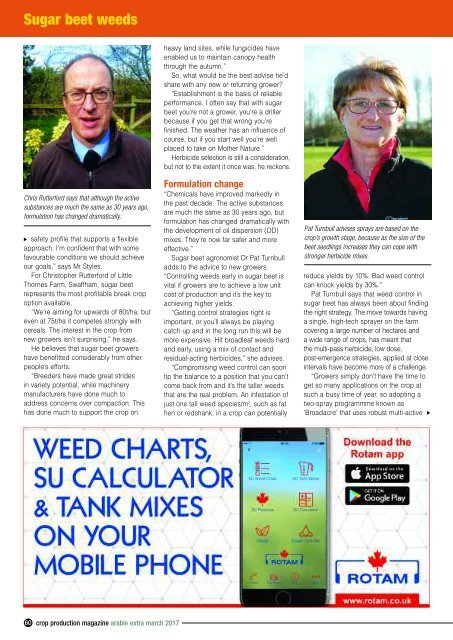In this issue..
CPM-March-Extra-2017
CPM-March-Extra-2017
Create successful ePaper yourself
Turn your PDF publications into a flip-book with our unique Google optimized e-Paper software.
Sugar beet weeds<br />
Chris Rutterford says that although the active<br />
substances are much the same as 30 years ago,<br />
formulation has changed dramatically.<br />
safety profile that supports a flexible<br />
approach. I’m confident that with some<br />
favourable conditions we should achieve<br />
our goals,” says Mr Styles.<br />
For Christopher Rutterford of Little<br />
Thornes Farm, Swaffham, sugar beet<br />
represents the most profitable break crop<br />
option available.<br />
“We’re aiming for upwards of 80t/ha, but<br />
even at 75t/ha it competes strongly with<br />
cereals. The interest in the crop from<br />
new growers isn’t surprising,” he says.<br />
He believes that sugar beet growers<br />
have benefitted considerably from other<br />
people’s efforts.<br />
“Breeders have made great strides<br />
in variety potential, while machinery<br />
manufacturers have done much to<br />
address concerns over compaction. This<br />
has done much to support the crop on<br />
▲<br />
heavy land sites, while fungicides have<br />
enabled us to maintain canopy health<br />
through the autumn.”<br />
So, what would be the best advise he’d<br />
share with any new or returning grower?<br />
“Establishment is the basis of reliable<br />
performance. I often say that with sugar<br />
beet you’re not a grower, you’re a driller<br />
because if you get that wrong you’re<br />
finished. The weather has an influence of<br />
course, but if you start well you’re well<br />
placed to take on Mother Nature.”<br />
Herbicide selection is still a consideration,<br />
but not to the extent it once was, he reckons.<br />
Formulation change<br />
“Chemicals have improved markedly in<br />
the past decade. The active substances<br />
are much the same as 30 years ago, but<br />
formulation has changed dramatically with<br />
the development of oil dispersion (OD)<br />
mixes. They’re now far safer and more<br />
effective.”<br />
Sugar beet agronomist Dr Pat Turnbull<br />
adds to the advice to new growers.<br />
“Controlling weeds early in sugar beet is<br />
vital if growers are to achieve a low unit<br />
cost of production and it’s the key to<br />
achieving higher yields.<br />
“Getting control strategies right is<br />
important, or you’ll always be playing<br />
catch up and in the long run <strong>this</strong> will be<br />
more expensive. Hit broadleaf weeds hard<br />
and early, using a mix of contact and<br />
residual-acting herbicides,” she advises.<br />
“Compromising weed control can soon<br />
tip the balance to a position that you can’t<br />
come back from and it’s the taller weeds<br />
that are the real problem. An infestation of<br />
just one tall weed species/m 2 , such as fat<br />
hen or redshank, in a crop can potentially<br />
Pat Turnbull advises sprays are based on the<br />
crop’s growth stage, because as the size of the<br />
beet seedlings increases they can cope with<br />
stronger herbicide mixes.<br />
reduce yields by 10%. Bad weed control<br />
can knock yields by 30%.”<br />
Pat Turnbull says that weed control in<br />
sugar beet has always been about finding<br />
the right strategy. The move towards having<br />
a single, high-tech sprayer on the farm<br />
covering a large number of hectares and<br />
a wide range of crops, has meant that<br />
the multi-pass herbicide, low dose,<br />
post-emergence strategies, applied at close<br />
intervals have become more of a challenge.<br />
“Growers simply don’t have the time to<br />
get so many applications on the crop at<br />
such a busy time of year, so adopting a<br />
two-spray programmme known as<br />
‘Broadacre’ that uses robust multi-active<br />
▲<br />
60 crop production magazine arable extra march 2017


